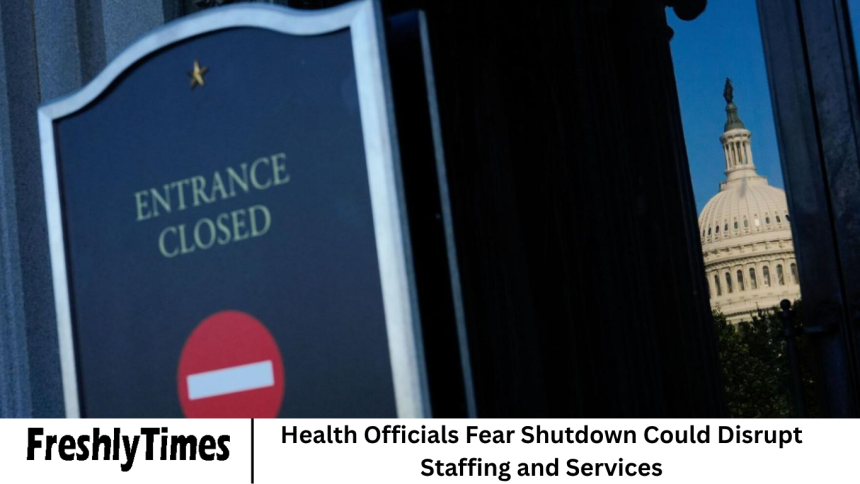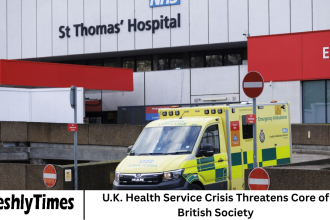As the threat of a federal government shutdown looms, local and state health departments across the United States are bracing for potential disruptions that could ripple through vital public health programs. From disease surveillance to nutrition assistance and vaccination initiatives.
- The Federal Lifeline Behind Local Health Systems
- Staffing Challenges: The Human Toll of a Funding Freeze
- Public Health Surveillance at Risk
- Nutrition Assistance Programs Face Uncertainty
- Emergency Preparedness and Outbreak Response
- Ripple Effects on Research and Healthcare Systems
- Disparities Could Deepen
- Economic Impact: The Cost of Inaction
- Lessons from Past Shutdowns
- Voices from the Field
- Possible Contingency Plans
- Public Health as a Nonpartisan Priority
- Frequently Asked Question
- Conclusion
The consequences of a funding freeze could stretch far beyond delayed paychecks. Public health officials, already strained from years of pandemic response and workforce shortages, warn that even a short shutdown could jeopardize critical services that millions of Americans rely on.
In recent weeks, organizations like the National Association of County and City Health Officials (NACCHO) and the Association of State and Territorial Health Officials (ASTHO) have raised alarms, urging Congress to avert a shutdown.
More Read: Short Intense Bursts of Activity That Leave You Breathless May Lower Cancer Risk
The Federal Lifeline Behind Local Health Systems
Most Americans may not realize how deeply local health services depend on federal funding. While state and county governments manage day-to-day operations, a substantial portion of their resources come from federal agencies such as:
- The Centers for Disease Control and Prevention (CDC)
- The Health Resources and Services Administration (HRSA)
- The Department of Agriculture (USDA)
- The Department of Health and Human Services (HHS)
These agencies channel billions of dollars annually into local health departments for disease surveillance, maternal and child health programs, immunization drives, and emergency preparedness. A government shutdown could pause or severely limit that flow of funds.
Many grants and contracts are tied to fiscal deadlines, and when agencies go dark during a shutdown, payments stop, reimbursements stall, and reporting deadlines freeze. For smaller local health departments, even a temporary halt could mean furloughs, delays in services, and interruptions in community outreach.
Staffing Challenges: The Human Toll of a Funding Freeze
Local health departments have been struggling to rebuild their workforce after the COVID-19 pandemic exhausted resources and staff morale. According to NACCHO, local health departments lost nearly 15% of their staff between 2008 and 2019, and many positions still remain unfilled today.
A shutdown could exacerbate these staffing challenges by forcing furloughs or pay delays for federally funded workers. In many communities, that could include nurses, epidemiologists, nutritionists, and public health educators — the very people responsible for keeping populations safe and informed.
For example, if CDC funds are frozen, state and local epidemiologists may lose access to national disease surveillance databases or be unable to report timely data on emerging threats. A delay of even a few days in reporting could have serious implications for controlling outbreaks like influenza.
Dr. Lori Tremmel Freeman, CEO of NACCHO, explained in a recent statement that “a government shutdown would create a dangerous vacuum in coordination between federal and local partners, leaving communities vulnerable to preventable health crises.”
Public Health Surveillance at Risk
One of the most immediate consequences of a shutdown would be the interruption of disease monitoring systems. These networks, coordinated by the CDC, rely on data flowing daily from state and local partners.
During a shutdown, CDC operations are often scaled back to “essential personnel” only, meaning non-emergency disease surveillance can slow or stop altogether. In the past, similar disruptions have affected tracking of:
- Influenza and RSV activity
- COVID-19 variant surveillance
- Foodborne illness outbreaks (Salmonella, E. coli, Listeria)
- Environmental hazards like lead exposure or water contamination
If federal analysts are furloughed, data pipelines could back up, making it harder to detect emerging trends. Local departments may still collect data, but without federal coordination, nationwide alerts and analyses could lag.
This problem isn’t hypothetical. During the 2013 shutdown, the CDC had to halt flu surveillance just as flu season began, creating blind spots for hospitals and doctors who rely on that data to prepare.
Nutrition Assistance Programs Face Uncertainty
Beyond disease prevention, a shutdown could directly affect millions of American families through disruptions to nutrition and food assistance programs. The Special Supplemental Nutrition Program for Women, Infants, and Children (WIC).
Which serves nearly 7 million participants each month, is one of the most vulnerable. Funded by the USDA, WIC provides food vouchers, breastfeeding support, and nutrition counseling to low-income mothers and children.
If the government shuts down, USDA operations could cease, halting funding distribution to state agencies. Some states may have short-term reserves, but many would run out of funds within days or weeks.
The Supplemental Nutrition Assistance Program (SNAP) — commonly known as food stamps — could also face administrative slowdowns, though benefits are typically protected for at least the first month of a shutdown.
Still, delays in processing applications or renewals could leave families uncertain about their next meal. Nutrition programs within schools may also be affected if USDA reimbursements are delayed. For many children, school meals are a lifeline — sometimes the only reliable source of nutrition they receive.
Emergency Preparedness and Outbreak Response
Local health departments also play a vital role in emergency preparedness — from natural disasters to bioterrorism response. Much of their capacity in this area depends on Public Health Emergency Preparedness (PHEP) grants from the CDC and Hospital Preparedness Program (HPP) grants from HHS.
If those grants are frozen, response readiness could suffer. For instance, a hurricane striking during a shutdown could stretch local agencies thin, as they might lack funds for overtime pay, emergency shelter supplies, or coordination with federal emergency management teams.
Moreover, the CDC’s Emergency Operations Center, which coordinates national responses to disease outbreaks, could operate with skeleton staff. That means fewer experts available to assist local departments if an outbreak suddenly escalates.
Ripple Effects on Research and Healthcare Systems
Shutdowns also reverberate through the nation’s biomedical research and healthcare infrastructure. Agencies like the National Institutes of Health (NIH) and Food and Drug Administration (FDA) often pause routine operations during funding lapses.
Clinical trials may halt new patient enrollment, delaying progress on treatments for cancer, Alzheimer’s, and rare diseases. FDA inspections of food facilities and drug manufacturers could also be postponed, increasing risks of contamination or shortages.
Hospitals, which often collaborate with federal agencies on surveillance and preparedness, could face coordination challenges. Many rely on timely federal data for infection control and public health guidance.
Disparities Could Deepen
Shutdowns rarely affect all communities equally. Underserved and rural areas — where local budgets are thinner — are often hit hardest. Health departments in these regions depend heavily on federal grants and technical assistance.
A prolonged shutdown could widen existing disparities in healthcare access, disease prevention, and nutrition security. Communities already struggling with chronic diseases, poverty, or limited healthcare access could face the greatest risks.
Furthermore, tribal health departments — many of which rely on funding from the Indian Health Service (IHS) — could see delays in care delivery or essential medical supplies.
For some tribal communities, this could mean interruptions in critical services such as diabetes management, immunizations, or prenatal care.
Economic Impact: The Cost of Inaction
While the fiscal focus of a shutdown is often on government spending, the indirect economic consequences can be just as damaging. When local health programs slow or stop, costs can compound over time.
Outbreaks become harder to contain, malnutrition rates rise, and chronic disease management falters. Each of these has a price tag — both in dollars and in human health outcomes. A 2019 Congressional Budget Office (CBO) report estimated that the 35-day shutdown earlier that year cost.
The U.S. economy $11 billion, with $3 billion in losses never recovered. Health-related delays and inefficiencies likely contributed to that figure. In short, the longer a shutdown lasts, the higher the health and economic costs become — and the harder it is for communities to recover afterward.
Lessons from Past Shutdowns
The U.S. has endured several federal government shutdowns over the past few decades, and each has offered painful lessons. During the 2013 shutdown, roughly 68% of CDC staff were furloughed, halting outbreak tracking, flu surveillance, and foodborne illness investigations.
The 2018–2019 shutdown — the longest in U.S. history — disrupted SNAP funding and caused widespread uncertainty in food assistance programs. Health officials say that despite those experiences, the underlying vulnerabilities remain.
Federal grants still form the backbone of many local operations, and there’s limited flexibility to maintain services without those funds.
Voices from the Field
Local health directors across the country are voicing concern. Dr. Umair Shah, Washington State’s Secretary of Health, recently warned that “even a temporary shutdown threatens to undo years of rebuilding our public health infrastructure.”
Dr. Denise Fair Razo, Detroit’s Chief Public Health Officer, noted that the uncertainty alone “creates anxiety among staff and communities who rely on consistent services.”
Dr. José Romero, Arkansas Secretary of Health, emphasized that “disease doesn’t wait for politics — our ability to respond should never be compromised.” These voices represent a common plea: keep the government open, not just for financial stability, but for the health and safety of the public.
Possible Contingency Plans
While local health departments are preparing contingency plans, their options are limited. Many are assessing how long they can maintain services using local funds or reserves, while others are prioritizing essential functions such as:
- Emergency response and outbreak control
- Immunization and disease reporting
- WIC and maternal-child health services
- Environmental health monitoring (water, sanitation, air quality)
However, even these stopgap measures have limits. Once local funds run out, the ability to sustain full operations diminishes rapidly.
Public Health as a Nonpartisan Priority
At its core, this issue transcends politics. Public health officials stress that keeping Americans safe from disease, hunger, and disaster should be a bipartisan commitment.
When funding becomes a bargaining chip in broader political battles, it’s the public who pays the price. Essential services — from tracking disease outbreaks to feeding children — hang in the balance.
As Dr. Freeman of NACCHO succinctly put it, “Public health doesn’t stop when politics start. Lives depend on uninterrupted funding and coordination.”
Frequently Asked Question
How would a government shutdown affect local health departments?
A shutdown could halt or delay federal funding, forcing local health departments to furlough staff, suspend programs, or delay payments for essential services. It would also disrupt coordination with agencies like the CDC and HHS.
Which health programs are most at risk during a shutdown?
Programs such as WIC, SNAP, disease surveillance, immunization efforts, and emergency preparedness grants are particularly vulnerable. Nutrition and maternal-child health services could face rapid disruption.
How long can local health departments operate without federal funding?
It varies by state and county. Some may use local reserves for a few weeks, but smaller departments could face service reductions almost immediately if federal reimbursements are frozen.
Will disease monitoring stop completely during a shutdown?
Not entirely, but it could slow significantly. CDC operations may scale back, and data sharing between states and federal agencies could be delayed, increasing risks of missed outbreaks.
How would a shutdown impact nutrition programs like WIC and SNAP?
WIC could run out of funds within days in many states, while SNAP might continue temporarily but with administrative slowdowns. Families could face uncertainty about food access.
Could hospitals and clinics be affected too?
Yes. Hospitals often rely on federal data and coordination for infection control, research trials, and public health preparedness. Some clinical research could pause, and FDA inspections may be delayed.
What can communities do during a shutdown to protect public health?
Local governments can prioritize essential services, coordinate with nonprofits, and communicate clearly with the public. Individuals can stay informed through local updates and help support food banks and aid programs.
Conclusion
A government shutdown is not just a bureaucratic inconvenience; it’s a potential public health emergency in slow motion. Every day that federal agencies remain closed increases risks — of missed disease outbreaks, delayed nutrition support, stalled research, and declining community health.
Health officials at every level are urging lawmakers to act swiftly, warning that public health infrastructure, already fragile, cannot withstand another blow. Whether Congress listens will determine more than just fiscal outcomes — it could shape the nation’s health for years to come.














